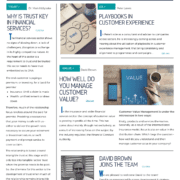No going back to the old way of managing customers and partners
No going back to the old way of managing customers and partners
Let’s face it, there is no going back to the old way we are used to in how we manage our customers and partners – the world has changed and we need to embrace the use of the hybrid world that has emerged as a result of the pandemic. As we come out from two years of work and life disruption, one thing is certain – managing customers and partners isn’t going to be the same again.
Hybrid working
We all did it and we did it ok – blending virtual and face-to-face interactions, this new hybrid customer / relationship management came to life and is here to stay. From what I have seen, in many cases this is what the customer wants, as it gives them more time to work on their own business and less dead time going to and from face-to-face meetings. So it in reality – it’s win-win – for everyone.
And you know the eagle-eyed finance directors out there immediately identified the budgetary upsides that this new way of working offered on the cost of customer management. However, make sure you put your customers and partners first instead of focusing on impressing the finance team.
This is an ideal opportunity to appraise the positives out of lockdown:
- What worked during the last two years?
- What didn’t work as effectively for our business and sector?
- How to /maintain / improve customer contact levels, quality of contact and frequency?
What did most of us do?
I for one, replaced customer ‘face-to-face’ meetings for ‘virtual’ meetings, improving my tech capabilities and competencies across multiple virtual platforms at rapid speed. And I even reacquainted myself with the ‘good old phone’ where I put it to good use calling customers and partners, listening to what they needed from me and offering ways I could help.
I’m sure you saw how it enabled commercial teams to improve the flexibility, frequency , applying good Training & Development, to the quality of their contacts too. The fact that the virtual move was reciprocated with an ‘we’re all in the same boat’ attitude meant customers and partners actually welcomed the move – allowing them to be more efficient and flexible. Going virtual gave us access to other people in the relationship on both sides as they could literally pop into the meeting without having to physically travel to that meeting.
Now that the restrictions have eased, is there really no going back to the old way of managing customers and partners?
I think the answer rests somewhere in the middle. The last two years identified a number of positive and negative influences.
- It was highly effective in managing customers for existing relationships with customers and partners
- The cost of customer management reduced significantly
- Developing new relationships was difficult – getting that initial emotional rapport via a virtual platform was challenging and still is.
- Winning new business was harder – selling your business proposition via a virtual platform instead of in a face-to-face meeting, required a lot of adapting of your existing capabilities
Let’s not forget the drain on our people too as 100% virtual is hard work and really tiring. I know I used to grumble about the daily train commute but actually, it often gave us some much needed downtime to reflect on the day and/or relax. Homeworking isn’t for everybody either – I heard so many stories where people struggled with the isolation which had a knock-on effect on their wellbeing and mental health.
What does the future of managing customers and partners look like?
If you’re in charge of your customer management teams, you need to stay flexible, mixing a blend of virtual and face-to-face interactions in a joined-up contact plan that you sit down and agree with your customers:
- Face to face = relationship development, relationship building, co-creating, joint business planning and business reviews
- Virtual = relationship management, relationship development and relationship delivery
This also has a potential upside if you operate a telesales, customer service or telephone-based account function. The high performers in these teams through adequate Training & Development develop additional virtual customer management capability and competencies. I have seen in B2B in particular, there has been so much buy-in to Teams and Zoom calls by providers and customers alike, but I need to point out, that these need a different style of engagement and a different set of skills to being on the telephone. Put your focus on developing these skills in your teams to enable virtual account management to be of benefit to your customers and to your business – career development opportunities and greater operational flexibility.
Selling Your Message Training
We do this well– give us a call and we can come and help you make it happen. Take a look at our latest flyer as this may be of real interest: Selling Our Message – Adapting for Delivering Between the Virtual and the Face-to-Face World
At the same time, it is worth re-visiting your customer base; look at how it is segmented to establish the appropriate customer management approach to match the relationship approach and potential.
However, that’s for another day and something we also help our trusted clients to develop.
![]() Does your company need help with selling your message in this new way of working? Please get in touch if you’d like to discuss further any of the issues raised in this blog.
Does your company need help with selling your message in this new way of working? Please get in touch if you’d like to discuss further any of the issues raised in this blog.
Further reading
Read the Customer Attuned Newszine on: The Impact of Hybrid Working on How we Build and Manage Customer Relationships
Read Alan’s blog on: Supporting clients as they manage their new homeworkers
Read Alan’s Blog on: Managing Customer Relationships in a Virtual world
Find out more about how we help companies develop people skills and capabilities
Follow Customer Attuned on Linked In and Twitter.
- It Takes Two To Tango - May 20, 2025
- Leveraging MBTI to build successful B2B relationships - October 25, 2024
- Making MBTI Work For Sales Teams - September 25, 2024





